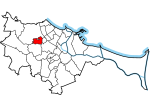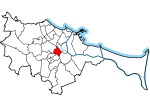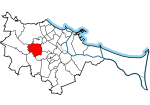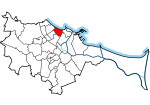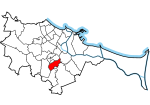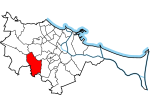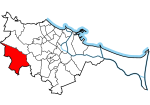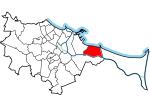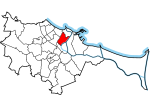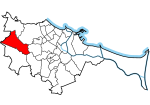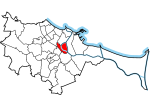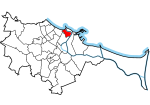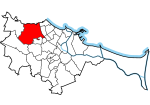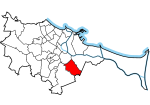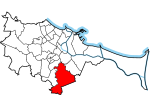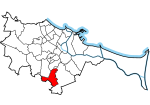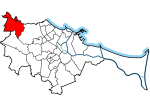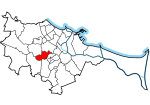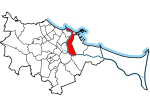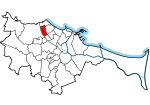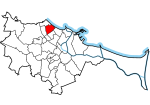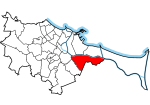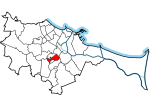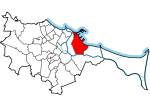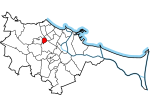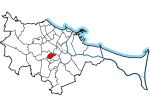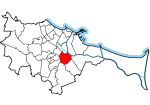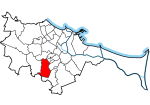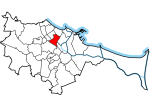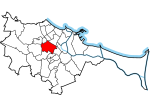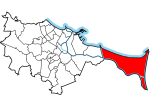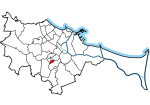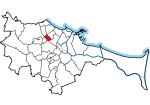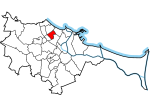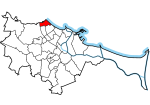Gdańsk
![]()
The title of this article is ambiguous. For other meanings, see Gdansk (disambiguation).
![]()
Gdańsk is a redirect to this article. For the ship of the same name, see Gdańsk (ship, 1927).
Gdansk (Polish Gdańsk [ɡdaɲsk] ![]() , Kashubian Gduńsk) is the capital of the Pomeranian Voivodeship on the Baltic coast in northern Poland. Gdansk is also the center of the geographical and cultural region of Kashubia. The former Hanseatic city, with its numerous shipyards and the country's largest seaport, is an important trading center.
, Kashubian Gduńsk) is the capital of the Pomeranian Voivodeship on the Baltic coast in northern Poland. Gdansk is also the center of the geographical and cultural region of Kashubia. The former Hanseatic city, with its numerous shipyards and the country's largest seaport, is an important trading center.
The independent city is located at the southern end of the Gdansk Bay at the outlet of the Motława River. This river connects Gdansk via the Vistula with the capital Warsaw, which lies 285 km to the southeast. With over 468,000 inhabitants, Gdansk is the sixth most populous city in the country. Together with the industrial port city of Gdynia and the resort town of Sopot, Gdansk forms the center of the country's fourth largest metropolitan region, the so-called Trójmiasto (Tri-City). More than 1.2 million people live in the entire urban agglomeration of Gdansk (aglomeracja gdańska).
In its complex urban history, Gdansk has been under Polish, later Prussian and German suzerainty since the Middle Ages, while it has always been understood as a cultural center by the West Slavic Kashubs as well. From 1454/66 to 1793 Gdansk was subject to the King of Poland, but with considerable autonomy; at that time Gdansk was one of the richest and largest cities in Poland, until it was overtaken by Warsaw in the 18th century. From 1807 to 1814 and from 1920 to 1939, Gdansk and its environs were a roughly sovereign city-state (for the interwar period, see Free City of Gdansk). In the interwar period, not least because of its history on the border between Germanness and Polishness, Gdansk was claimed by both states, which led to numerous tensions due to its location on the so-called Polish Corridor. These culminated in Germany's attack on Poland at the city gates of Gdansk in 1939, followed by the murder of the Polish, Kashubian and Jewish populations by the Nazis, and the flight and expulsion of the majority of the ethnic German population in 1945. After World War II, displaced Poles also settled from areas that Poland was forced to cede to the Soviet Union.
In the 1980s, Gdansk was the center of the oppositional anti-communist movement, which found its center in the Solidarność trade union led by Lech Wałęsa. This played an important role in ending communist rule in Poland and influenced the decline of communist regimes throughout the Eastern Bloc, up to the fall of the Berlin Wall and the dissolution of the Soviet Union.
Important institutions in Gdansk are the University of Gdansk, the Gdansk University of Technology, the National Museum, the Gdańsk Shakespeare Theatre, the World War II Museum, the Baltic Philharmonic Orchestra and the European Solidarność Center.

(1) View from St. Mary's Church to the Rechtstädtisches Rathaus and Langgasse, (2) View from Motława to the city, (3) The lady from the window, (4) Neptune's Fountain, (5) Arthur's Court with Neptune's Fountain, (6) Pope John Paul II Bridge.
Geography
Geographical position
The city is located in the south of the Gdansk Bay and west of the mouth of the Vistula River in a hilly landscape surrounded by large pine forests. 20 kilometers to the north is the Hel Peninsula. The Old Town of Gdansk is located on the Motława (Motlawa) River. To the west of Gdansk lies the historic region of Kashubia. Furthermore, the area is known for the occurrence and processing of amber.
Neighboring communities
To the northwest, Gdansk borders the Baltic Sea resort of Sopot. Together with the city of Gdynia further to the north, these three cities form the Trójmiasto conurbation with a population of just under 750,000. The entire agglomeration (the Aglomeracja gdańska) is home to about 1.25 million inhabitants, including the cities of Dirschau (Tczew), Neustadt (Wejherowo) and Rahmel (Rumia). To the north, the city borders on the Gdansk Bay, and to the east on the main stream of the Vistula River. Here there are only smaller villages belonging to the rural commune of Steegen (Stegna). To the south, the city is bordered by the municipalities of the Gdański County, from east to west: Cedry Wielkie, Pruszcz Gdański, the city of Praust, again its independent rural municipality, and the rural municipality of Kolbudy. To the west, Gdańsk borders on the rural commune of Zuckau (Żukowo) in the district of Karthaus (Powiat Kartuski).
City breakdown
As of March 2019, the city consists of 35 administrative districts, the number had increased by four in 2011 and one in 2019 due to district divisions.
There was no division into administrative districts in Gdansk before 1939 or 1945. Many places that today belong to the city and its districts were incorporated into the districts of Danziger Höhe and Danziger Niederung. By 1973, the city area had expanded considerably due to incorporations.
The current and historic district or township boundaries are not always congruent.
| District name | German place or | Area in km² | Population | Population density | Map |
| VII Dwór | Pelonken (VII Court) | 03,0115 | 03.820 | 1.268 |
|
| Aniołki | All angel | 02,3079 | 04.922 | 2.133 |
|
| Brętowo | Brentau | 07,0843 | 07.643 | 1.079 |
|
| Brzeźno | Brösen | 02,7409 | 13.457 | 4.910 |
|
| Chełm | Stolzenberg | 03,89 | 32.242 | 8.288 |
|
| Jasień | Nenkau | 11,4833 | 08.157 | 00710 |
|
| Kokoszki | Cocoschken | 19,8447 | 07.465 | 00376 |
|
| Krakowiec-Górki Zachodnie | Krakow and West Neufähr | 08,3796 | 01.994 | 00238 |
|
| Letnica | Lauenthal/ Lauental | 04,029 | 01.333 | 00331 |
|
| Matarnia | Mattern | 14,4268 | 05.787 | 00401 |
|
| Młyniska | Schellmühl | 04,1813 | 03.404 | 00814 |
|
| Nowy Port | Neufahrwasser | 02,2786 | 10.684 | 4.689 |
|
| Oliwa | Oliva | 18,3997 | 17.728 | 00963 |
|
| Olszynka | Large and small Walddorf | 07,9696 | 03.209 | 00403 |
|
| Orunia-Św. Wojciech-Lipce | Ohra, St. Albrecht and Guteherberge | 19,634 | 15.867 | 00808 |
|
| Orunia Górna-Gdańsk Południe | Borgfeld, Matzkau | 07,2 | 19.807 | 2.751 |
|
| Osowa | Aspen Pitcher | 14,1338 | 13.245 | 00937 |
|
| Piecki-Migowo | Pietzkendorf and Müggau | 04,3165 | 22.852 | 5.294 |
|
| Przeróbka | Troyl | 07,0978 | 04.816 | 00679 |
|
| Przymorze Małe | Konradshammer | 02,3274 | 15.348 | 6.594 |
|
| Przymorze Wielkie | Konradshammer | 03,117 | 30.346 | 9.736 |
|
| Rudniki | Civic Meadows | 14,1853 | 01.452 | 00102 |
|
| Siedlce | Schidlitz | 02,6429 | 14.359 | 5.433 |
|
| Stogi | Hay shack | 10,9634 | 12.128 | 1.106 |
|
| Strzyża | Hochstrieß | 01,0863 | 05.759 | 5.301 |
|
| Suchanino | Zigankenberg | 01,4011 | 11.234 | 8.018 |
|
| Śródmieście | formerly: Rechtstadt, Altstadt, Neugarten, Hagelsberg, Bischofsberg, Vorstadt, Speicherinsel, Bleihof, Langgarten, Niederstadt, Strohdeich | 05,6245 | 30.648 | 5.449 |
|
| Ujeścisko-Łostowice | Wonneberg and Schönfeld | 07,7945 | 17.797 | 2.283 |
|
| Wrzeszcz Dolny | Langfuhr | 03,5219 | 25.817 | 7.330 |
|
| Wrzeszcz Górny | Langfuhr | 06,4572 | 24.298 | 3.763 |
|
| Wyspa Sobieszewska | "Bohnsacker Island" | 35,7897 | 03.443 | 00096 |
|
| Wzgórze Mickiewicza | Neuwonneberg | 00,5277 | 02.570 | 4.870 |
|
| Zaspa-Młyniec | Saspe (mill yard) | 01,2322 | 14.295 | 11.601 |
|
| Zaspa-Rozstaje | Saspe (corner yard) | 02,0322 | 12.794 | 6.296 |
|
| Żabianka-Wejhera-Jelitkowo-Tysiąclecia | Poggenkrug, | 02,3336 | 18.546 | 7.947 |
|
Climate
Gdansk is located in the temperate zone, in the transitional zone between the oceanic climate (Cfb) and the continental climate (Dfb), with predominantly cold winter and mild summer temperatures. The hottest month is August, which has an average maximum temperature of 21.3 °C. The days with the highest precipitation are also found in summer, which is an indicator of continentality. The total amount of precipitation is quite low, 507 mm per year.
| Gdansk | ||||||||||||||||||||||||||||||||||||||||||||||||
| Climate diagram | ||||||||||||||||||||||||||||||||||||||||||||||||
| ||||||||||||||||||||||||||||||||||||||||||||||||
| Monthly average temperatures and precipitation for Gdansk
Source: WMO | ||||||||||||||||||||||||||||||||||||||||||||||||||||||||||||||||||||||||||||||||||||||||||||||||||||||||||||||||||||||||||||||||||||||||||||||||||||||||||||||||||||||||||||||||||||||||||||||||
Etymology
It is no longer possible to derive the name of the town with certainty. The oldest surviving form of the name, Gyddanyzc, is contained in the Latin text of the biography of Adalbert written around 1000, traditionally attributed to the Roman Benedictine monk Canaparius. In the Bohemian dialect of the missionary Adalbert, the village is said to have been called Gidanie, and in documents of the 12th and 13th centuries it is called Gdanczk, Gdansk, Gdanz or Gedanc. On the tombstone of the mayor Letzkau, who was murdered in 1411, it is called Danske. It is not improbable that the name of the city was originally based on the name of a special place, which was called Danish, e.g. a bridge, a customs station or a settlement spot. Although the castle and the village of Gdansk had been forced under the fiefdom of the Danish crown in 1210 and had been reconquered by Duke Swantopolk II only in 1227, only Danish influences at least 200 years further back could be considered for a plausible derivation. In connection with the etymological question, the name of a Gothic fortress (Gothorum castellum), Gothiscanzia (Gothic redoubt), which is said to have once existed here, has also been thrown into the balance.
Politics
City President
→ Main article: List of mayors of Gdansk
The city administration is headed by a city president who is elected by direct vote of the population. Since 1998, this has been Paweł Adamowicz (formerly Platforma Obywatelska, from 2015 "All for Gdansk"). The last regular election in 2018 resulted in the following:
- Paweł Adamowicz (All for Gdansk) 37.0% of the vote
- Kacper Płażyński (Prawo i Sprawiedliwość) 29.7% of the vote
- Jarosław Wałęsa (Koalicja Obywatelska) 27.8% of the vote
- Other 5.5 % of votes
In the second round of voting, the incumbent Adamowicz prevailed with 64.8% of the vote against PiS candidate Płażyński, who received 35.2% of the vote. Adamowicz was assassinated on January 13, 2019, and died as a result the following day. His deputy Aleksandra Dulkiewicz was subsequently appointed acting city president by the voivode. In the necessary new election on March 3, 2019, she stood for Adamowicz's voters' association "All for Gdansk" and was also supported by the PO, the PSL, Nowoczesna and Wiosna. She was already elected in the first round with 82.2% of the vote. Her opponents Grzegorz Braun (Konfederacja Korony Polskiej) and Marek Skiba (independent) were far behind with 11.9% and 5.9% of the vote respectively.
City Council
The City Council consists of 34 members and is directly elected. The 2018 City Council election resulted in the following:
- Koalicja Obywatelska (KO) 39.3% of the vote, 16 seats
- Prawo i Sprawiedliwość (PiS) 26.3% of the vote, 12 seats
- Election Committee All for Gdansk 19.1% of votes, 6 seats
- Gdansk Residents Election Committee 6.5% of the vote, no seat
- Electoral Committee Gdansk City Movement 5.2% of the vote, no seat
- Sojusz Lewicy Demokratycznej (SLD) / Lewica Razem (LR) 3.1 % of the vote, no seat
- Other 0.6% of votes, no seat
Coat of arms
→ Main article: Gdansk coat of arms
The Great Coat of Arms of the City of Gdansk consists of a Gothic shield flanked by two golden lions. The red shield contains an open golden crown at the top and two equal-armed silver (white) crosses below. At the feet of the shield and the shield holders it shows in a golden bow the motto written in black: nec temere nec timide - neither rash nor timid.
Town twinning
Partnership cooperation and twinning exist with the following cities:
| City | Country | since | Type |
| Aarhus | Denmark | dormant | |
| Barcelona | Spain | 1990 | Cooperation |
| Bremen | Germany | 1976 | Twin city |
| Cleveland | United States | 1990 | Twin city |
| Gent | Belgium | 2009 | Cooperation |
| Helsingør | Denmark | 1992 | Cooperation |
| Kaliningrad | Russia | 1993 | Twin city |
| Squid | Sweden | 1991 | Twin city |
| Marseille | France | 1992 | Twin city |
| Navapolazk | Belarus | 2009 | Cooperation |
| Newcastle upon Tyne | United Kingdom | 2001 | Cooperation |
| Nice | France | 1999 | Twin city |
| Nur-Sultan | Kazakhstan | 1996 | Twin city |
| Odessa | Ukraine | 1996 | Twin city |
| Omsk | Russia | 2008 | Cooperation |
| Palermo | Italy | 2005 | Cooperation |
| Rijeka | Croatia | Cooperation | |
| Rotterdam | Netherlands | 1997 | Twin city |
| Rouen | France | 1992 | Cooperation |
| Saint Petersburg | Russia | 1997 | Twin city |
| Sefton | United Kingdom | 1993 | Twin city |
| Shanghai | China People's Republic of | 2004 | Cooperation |
| Turku | Finland | 1976 | Twin city |
| Vilnius | Lithuania | 1998 | Twin city |
- ↑ The name of Aarhus is currently still on a partnership signpost in front of Gdansk's New City Hall. According to information from the city of Gdansk, the partnership has "fallen asleep" in the meantime. (Status: January 2016)
New Hanse
The city of Gdansk is a member of the New Hanseatic League of Cities, and in 1997 it hosted the 17th Hanseatic Convention of the Modern Era.
Culture
Culinary specialties
- Gdansk Gold Water
- Gdansk Machandel, a juniper brandy.
Events
In August, the Dominican Market takes place, which lasts several weeks and is also attended by many out-of-towners. It originated from an indulgence privilege for the feast of St. Dominic (August 8).
Music
- Baltic Philharmonic Orchestra (Polska Filharmonia Bałtycka im. Fryderyka Chopina)
- Baltic Opera (Opera Bałtycka)
Theater
- Theater at the Coal Market (Teatr Wybrzeże)
- Shakespeare Theater (Gdański Teatr Szekspirowski)
Museums
- European Solidarity Center (Europejskie Centrum Solidarności)
- Museum of the Second World War (Muzeum II Wojny Światowej) / Westerplatte Museum (Muzeum Westerplatte i Wojny 1939)
- National Museum (Muzeum Narodowe w Gdańsku)
- Archaeological Museum (Muzeum Archeologiczne w Gdańsku)
- Historical Museum (Muzeum Historyczne Miasta Gdańska)
- City Hall (Ratusz Głównego Miasta)
- Artus Court (Dwór Artusa)
- Uphagen House (Dom Uphagena)
- Tower Clock Museum (Muzeum Nauki Gdańskiej) in St. Catherine's Church
- Amber Museum (Muzeum Bursztynu) in the Stock Tower and Peinkammer Gate
- Fortress Vistula Mouth (Twierdza Wisłoujście)
- Guard House No. 1 on Westerplatte (Wartownia nr 1 na Westerplatte)
- Museum of the Polish Post (Muzeum Poczty Polskiej)
- National Maritime Museum (Narodowe Muzeum Morskie w Gdańsku)
- Center for Maritime Culture (Ośrodek Kultury Morskiej)
- Memory on the island of Ołowianka (Spichlerze na Ołowiance)
- Museum ship Sołdek
- Crane Gate (Brama Żuraw)
Buildings
Architecture
→ Main article: Architecture in Gdansk
Secular buildings
- Crane gate
- Green gate
- Right Town Hall
- Great armory
- Artus Court
- Courtyard of the St. George Rifle Brotherhood
- To the salmon
- Large mill
- Old Town Hall
- Langgasser Gate
- High gate
- Stockturm
- Lwi Dwór
- Fortress Vistula mouth
- Anchor forge tower
- Low Gate (Gdansk)
Churches
- St. Mary's Church - Hall Church (Bazylika Mariacka)
- Oliva Cathedral (Katedra Oliwska), the burial place of Anton Möller, the "painter of Gdansk".
- St. Bartholomew's Church (Kościół św. Bartłomieja)
- St. Brigitte's Church - Basilica (Bazylika św. Brygidy)
- St. John's Church (Kościół św. Jana)
- Church of St. Joseph (Kościół św. Józefa)
- Royal Chapel (Kaplica Królewska)
- Mennonite Church (Kościół Menonitów)
- St. Catherine's Church (Kościół św. Katarzyny)
- Church of St. Nicholas (Kościół św. Mikołaja)
- Peter and Paul Church (Kościół św. Piotra i Pawła)
- Trinity Church (Kościół św. Trójcy)
Other sacral buildings
- Gdansk mosque
- New synagogue in Langfuhr (Wrzeszcz)
Squares and streets
- Frauengasse
- Long market
- Langgasse
- Long bridge
Monuments and fountains
- Westerplatte monument, honorary graves and a permanent exhibition at Westerplatte.
- Monument to the fallen shipyard workers of 1970 in front of the Solidarność Center
- Neptune Fountain
- two Heweliusz monuments and the
- Heweliusz fountain in the Old Town
- Monument to Günter Grass and the tin drummer Oskar in Langfuhr (Wrzeszcz, plac generala Jozefa Wybickiego)
- Cemetery of the non-existent cemeteries.
Natural plants
Parks and beaches
- Fortress area at the Mottlau, 12 ha
- Eco Hewelianum on the fortress area of the Hagelsberg
- Ronald Reagan Park between Brösen and Glettkau, 200 ha
- Park Kuźniczki in Langfuhr (Wrzeszcz)
- Park Oruński (formerly Hoene Park) in the district Ohra
- Oliva Park (Park Oliwski), 11 ha; with the
- Oliva Botanical Garden (Ogród Botaniczny w Oliwie)
- Zoological Garden (Miejski Ogród Zoologiczny Wybrzeża) in the Oliwa district, 136 ha, founded in 1954.
- Tricity Landscape Park (TPK), 20,000 ha
The big city of Gdansk has five beaches of its own, which can be reached by public transport. The first two have guarded bathing establishments.
- Brösen (Brzeźno)
- pier (Molo), 130 m long
- Hay shack (Stogi) (with nudist beach)
- Glettkau (Jelitkowo)
- Bean bag (Sobieszewo)
- Wordel (Sobieszewo-Orle)
Nature reserves and natural monuments
- 7 Nature reserves in the area of the TPK Landscape Park.
- Nature reserves on the Bohnsacker Island
- Bird sanctuary Ptasi Raj
- 144 natural monuments:
- 88 Trees and groves
- 2 trees on boulders
- 52 Erratic blocks and rock groups
- 2 Surface objects
Sports
Soccer
Gdansk was one of four Polish venues for the 2012 European Football Championship. Three group matches and one quarterfinal of the tournament were played at the newly built PGE Arena Gdańsk. Lechia Gdańsk has played in the Ekstraklasa, Poland's top soccer league, since 2008.
Handball and volleyball
Ergo Arena is a multifunctional hall on the city border with Sopot. It was opened in 2010 and hosted the 2013 European Men's Volleyball Championship, the 2014 World Men's Volleyball Championship and the 15th World Indoor Athletics Championships in 2014. In 2016 it hosted six preliminary round matches 12th European Men's Handball Championship.
Ice hockey
Gdansk ice hockey team PKH Gdańsk, founded in 2014, has been playing in the first-class Polska Hokej Liga since 2016. GKS Stoczniowiec, founded in 1970, has been playing in the second-tier I liga since 2017. The home ground of both clubs is the ice stadium "Olivia", which dates back to 1972 and has a capacity of about 5000 spectators. It hosted the 2004 World Ice Hockey Championship (Div. I, Gr. B) and the 2009 European Basketball Championship.

Ergo Arena
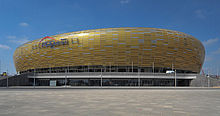
PGE Arena Gdańsk

Westerplatte Monument

Baltic opera

Baltic Philharmonic Orchestra
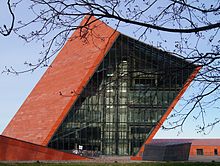
Museum of the Second World War (Muzeum II Wojny Światowej)
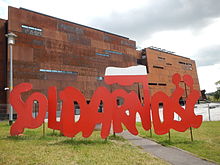
European Center of Solidarność
.jpg)
Green Gate at the Long Market by night
.JPG)
St. Mary's Church
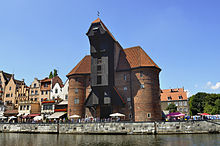
Crane gate
Economy and infrastructure
Traffic
Gdansk was connected to central and southern Poland as well as Slovakia and the Czech Republic via the A1 freeway in 2013.
The city can be reached by rail directly from the main Polish cities, from and to Warsaw by the Warszawa-Gdańsk railroad line, and in the direction of Szczecin by the Gdańsk-Stargard railroad line. Since June 6, 2012, a through connection to and from Berlin has also been offered again with the EuroCity 55. All long-distance trains also stop at the Wrzeszcz and Oliwa district stations.
There is a suburban railroad (SKM Szybka Kolej Miejska w Trójmieście) connecting Gdansk with Sopot, Gdynia and Wejherowo. From Wrzeszcz, the PKM suburban railroad connects the city with the airport.
In 2015, the Gdańsk Wrzeszcz-Gdańsk Osowa railroad line was opened.
Inner-city public transport is handled by SKM, the Gdansk streetcar and a dense network of bus lines on Gdansk's streets.
Since Poland's accession to the EU, Gdansk Airport has been growing strongly. It is the third largest airport in Poland (after Warsaw and Krakow; as of 2014). In 2010, it handled over 2.23 million passengers. It is served by over 40 national and international airlines, including Lufthansa (from Frankfurt and Munich) or the low-cost airlines Ryanair and Wizz Air.
The port of Gdansk is currently the largest Polish port. In 2012, it handled a total of 26.9 million tons. Furthermore, the city can be reached via a ferry connection from Sweden (Nynäshamn).
The bridge Most 100-lecia Odzyskania Niepodległości Polski was created in 2018.
From smaller inner-city piers on the Motlawa river, excursion boats operate regularly mainly on the tourist routes to Westerplatte, Sopot and Gdynia (lines F1 and F2). Since June 2012, two new tourist and inner-city ferry lines have been operating regularly on the Motlau from the beginning of June to the beginning of September, connecting the city center from the Poggenpfuhl pier (Żabi Kruk) with the Westerplatte (Line F5) and the Fish Market (Targ Rybny) with the mouth of the Vistula (Narodowe Centrum Żeglarstwa) (Line F6).
Gdansk is connected to several official international long-distance cycling routes, such as the Baltic Coastal Cycle Route, which circles the Baltic Sea once, and the Iron Curtain Trail, which runs along the former "Iron Curtain" from Norway to the Black Sea.
Resident companies (selection)
Gdansk has been known as a trading city since the Hanseatic period mainly because of its favorable location on the Baltic Sea. The port still plays a major role in the Polish economy with 23.3 million tons of cargo handled (2004). The city's main industries are shipbuilding (e.g. Gdansk Shipyard - Stocznia Gdańsk, Remontowa SA repair and offshore service yard, Northern Shipyard SA), petrochemical and chemical industries (e.g. Grupa LOTOS SA), and more recently high technologies such as electronics (e.g. Intel or WS OY (Young Digital Poland)), telecommunications and information technology (e.g. Wirtualna Polska, Lido Technologies). The pharmaceutical industry, food industry (e.g. PepsiCo (USA), Dr. Oetker (Germany), Fazer OY (Finland) and Baltic Malt/Malteurop (France)) and cosmetics sector are also gaining importance.
Tourism
Gdansk is the starting point of the EuroVelo 9 cycle route (Baltic Sea-Adriatic Sea Route or Amber Route, Polish Szlak bursztynowy), which runs from Gdansk through Poland, the Czech Republic, Austria and Slovenia to Pula in Croatia. The EuroVelo 10 (Baltic Sea Cycle Route or Hanseatic Route, Polish Obwód Hanzeatycki), which is laid out around the Baltic Sea, also passes through Gdansk.
Tourism is an important source of income with about 1.5 million tourists annually.
Education
In Gdansk there are, among others, ten universities with about 60,000 students and about 10,000 graduates annually (as of 2001). These are
- University of Gdansk (Uniwersytet Gdański) (33,000 students)
- Gdansk University of Technology (Politechnika Gdańska) (18,000 students)
- Gdansk Medical University (Gdański Uniwersytet Medyczny)
- Gdansk University of Physical Education (Akademia Wychowania Fizycznego im. Jędrzeja Śniadeckiego)
- Gdansk Academy of Music (Akademia Muzyczna im. Stanisława Moniuszki)
- Academy of Arts Gdansk (Akademia Sztuk Pięknych)
- Ateneum - Szkoła Wyższa
- Gdańska Wyższa Szkoła Humanistyczna
- Gdańska Wyższa Szkoła Administracji
- Wyższa Szkoła Bankowa
- Wyższa Szkoła Społeczno-Ekonomiczna
- Wyższa Szkoła Turystyki i Hotelarstwa w Gdańsku
- Wyższa Szkoła Zarządzania and
- Polish Academy of Sciences, Gdansk Regional Branch (Polska Akademia Nauk, Oddział w Gdańsku).

Gdansk University of Technology Main Building

Lech Wałęsa Airport Gdansk

Gdansk Central Station
Personalities
The list of personalities of the city of Gdansk includes personalities born in the city or working in the city. The personalities appointed by the city as honorary citizens can be found in the list of honorary citizens of Gdansk.
Among the most famous personalities of Gdansk are Abraham van den Blocke, Izaak van den Blocke, Ludwig August Clericus, Daniel Gabriel Fahrenheit, Andreas Schlüter, Jakob Friedrich von Rüchel-Kleist, Arthur Schopenhauer, Johannes Hevelius, Daniel Chodowiecki, Holger Czukay, Hugo Conwentz, Richard Faltin, Günter Grass, Klaus Kinski, Anton Möller (the "painter of Gdansk"), Horst Ehmke, Rupert Neudeck, Paweł Huelle, Lech Wałęsa, Dariusz Michalczewski, Tomasz Wałdoch, Andrzej Grubba and Donald Tusk.
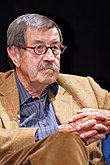
Günter Grass
Search within the encyclopedia
